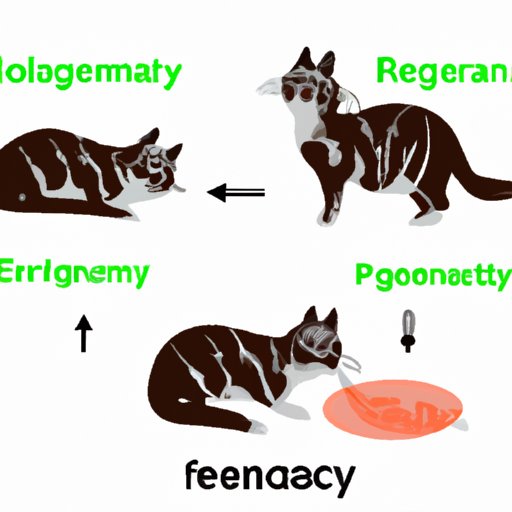
Introduction
For cat owners, determining how far along their cat is in their pregnancy can be a tricky task. Unlike humans, cats don’t show obvious physical signs immediately. However, it is important to know the stages of feline pregnancy in order to provide appropriate care for both the mother and her kittens. In this guide, we’ll cover how to tell if your cat is pregnant and determine the stages of feline pregnancy so you can track your cat’s progress from conception to birth.
5 Signs to Indicate Your Cat is Pregnant: A Guide for Pet Owners
While cats may not show symptoms of pregnancy early on, there are still some signs that indicate a cat is pregnant.
Breeding History
If your cat is intact and has been allowed to mate, pregnancy is a strong possibility. Keep in mind that cats can become pregnant as young as 4 months old, so it’s important to spay and neuter your pets if you don’t wish for them to breed.
Changes in Nipples/Mammary Glands
Around 2-3 weeks after conception, your cat’s nipples may appear enlarged, pinker, or darker. You may also feel small bumps called “mammary buds” developing.
Weight Gain
As the pregnancy progresses, your cat will gain weight. This can be difficult to notice in long-haired cats, so it’s important to monitor weight regularly to detect any changes.
Behavioural Changes
During pregnancy, a cat’s behaviour may change. They may become more affectionate or more vocal than usual. Some cats may experience morning sickness or lose their appetite.
Nesting Behaviour
As labour approaches, your cat may begin to seek out a quiet and comfortable place to give birth. They may start to nest by kneading or rearranging blankets in preparation for their kittens.
Understanding the Stages of Feline Pregnancy: How to Know How Far Along Your Cat is
Feline pregnancy typically lasts around 63-65 days. It is divided into three stages: early, mid, and late.
Physical and Behavioural Changes for Each Stage
During the early stage (week 1-3), your cat may not show any visible signs of pregnancy, but development begins. In the mid-stage (week 4-6), your cat’s belly will start to enlarge, and you can feel her kittens moving. During the late stage (week 7-9), your cat may seem restless and anxious, indicating that labour is near.
How to Use Symptoms to Determine Which Stage of Pregnancy the Cat is In
If your cat is showing early signs of pregnancy, she is likely in the early stage. Once you begin to notice visible signs of pregnancy, such as weight gain and changes in behaviour, your cat is likely in the mid-stage. In the late stage, look for signs of restlessness and nesting behaviour to indicate labour is near.
Cat Pregnancy: Tracking Progress from Conception to Birth
How to Monitor the Cat’s Health During Pregnancy
During pregnancy, it is important to monitor your cat’s health and nutrition closely. Feed them a high-quality diet and provide plenty of fresh water. Keep track of her weight and watch for any abnormal behaviours or symptoms.
Ultrasound and X-Ray Options for Tracking Progress
If you want to know how many kittens your cat is carrying, an ultrasound can be performed around 25 days after conception. X-rays can also be done later in pregnancy to give you an estimated count of how many kittens she will have.
Tips for Making Veterinary Appointments Easier for Pregnant Cats
To make veterinary appointments easier for pregnant cats, make sure to call the vet ahead of time and let them know you’re bringing in a pregnant cat. Bring a comfortable carrier for your cat, and make sure to keep her calm and relaxed on the way to the appointment.
How to Calculate Your Cat’s Due Date: A Pregnancy Timeline for Felines
Factors That Influence Due Dates
A cat’s pregnancy timeline can vary depending on several factors, such as age, breed, and number of kittens.
Calculation Methods for Predicting the Due Date
If you know the date your cat mated, you can predict the due date by adding 63-65 days. You can also use ultrasound to estimate the due date or consult with your veterinarian.
The Importance of Knowing the Due Date for Planning and Preparation
Knowing the due date can help you plan for your cat’s labour and delivery, such as preparing a space for her to give birth and making sure you have all the necessary supplies. It can also help you monitor your cat for signs of potential complications.
Helping Your Cat Through Pregnancy: Identifying the Key Stages
Nutrition and Diet Recommendations
During pregnancy, your cat needs a balanced and nutritious diet to support her and her kittens. Provide her with high-quality, high-protein food and plenty of fresh water. Consider consulting with your veterinarian about specific nutritional needs during pregnancy.
Managing the Cat’s Behaviour During Pregnancy
As mentioned earlier, pregnancy can cause behavioural changes in your cat. It is important to provide a calm and comfortable environment for her to reduce stress. Keep her litter box clean and easily accessible to avoid accidents.
Preparing for the Labour and Delivery Process
As labour approaches, prepare a comfortable and quiet place for your cat to give birth. Monitor her closely for any signs of labour, such as nesting behaviour and contractions.
Postnatal Care for the Mother and Kittens
After delivery, monitor the mother and kittens closely to ensure they are healthy and getting enough milk. Provide a warm and secure environment for them to bond and grow. Consult with your veterinarian about any necessary vaccinations and health checks for the kittens.
Conclusion
As a pet owner, understanding feline pregnancy is crucial to providing proper care for your cat and her kittens. By monitoring your cat’s health, determining the stages of pregnancy, and calculating the due date, you can ensure that both the mother and the kittens are healthy and well-cared for. Be proactive in helping your cat through pregnancy to ensure a safe and successful delivery.




